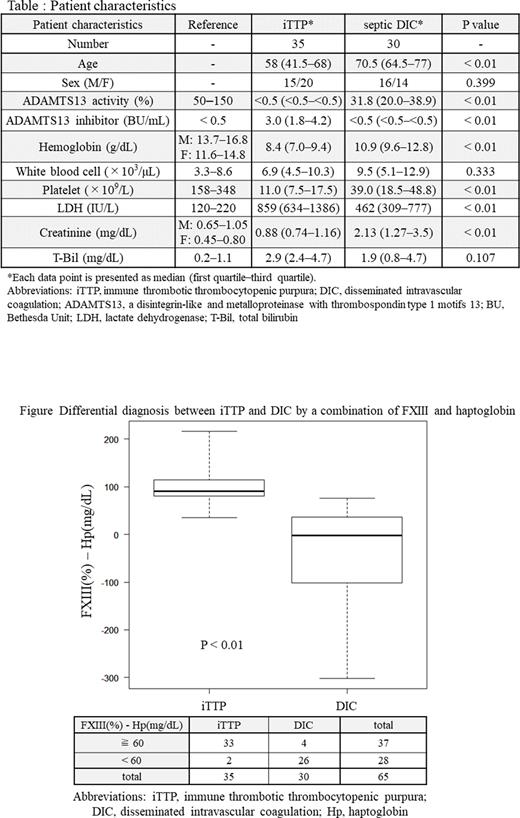Abstract
Introduction Differential diagnosis of immune thrombotic thrombocytopenic purpura (iTTP) and septic disseminated intravascular coagulation (DIC) in daily clinical practice is difficult. iTTP is diagnosed by deficiency of ADAMTS13 activity and ADAMTS13 inhibitor positivity. However, it is difficult to rapidly measure ADAMTS13 activity in real-time in clinical practice. Prompt therapeutic interventions are directly dependent on iTTP prognosis. A method for differentiating between these two disorders using common laboratory tests is needed. Plasma haptoglobin levels can indicate hemolysis and are reported to be severely decreased in iTTP. Coagulation factor XIII (FXIII) activity is also severely decreased in septic DIC. To date, no reports have observed haptoglobin in septic DIC or FXIII activity in iTTP. We analyzed the plasma levels of haptoglobin and FXIII activity in patients with iTTP and septic DIC to investigate whether these markers can be used for differential diagnosis.
Methods iTTP was defined as <10% normal ADAMTS13 activity, and >0.5 BU/mL ADAMTS13 inhibitor. Septic DIC was defined as meeting both Third International Consensus Definitions for Sepsis and Septic Shock, and ISTH DIC diagnostic criteria. Thirty-five patients with iTTP and 30 with septic DIC were enrolled in this study. Plasma haptoglobin levels were measured using Human Quantikine ELISA Kits (#DPHAGO, R&D Systems, Inc., Minneapolis, USA), which is a highly sensitive method compared to methods used in clinical practice. Values are expressed as medians (first quartile-third quartile).
Results As shown in the table, iTTP patients were significantly younger than those with septic DIC. The iTTP group showed significantly lower ADAMTS13 activity, higher ADAMTS13 inhibitor titer, lower hemoglobin level, lower platelet counts, higher LDH level, and lower creatinine level than the septic DIC group. In a comparison of coagulation and fibrinolytic markers, the septic DIC group had significantly higher PT-INR, prolonged APTT, higher FDP and D-dimer levels, and lower AT activity than the iTTP group. The plasma haptoglobin level was 0.39 mg/dL (0.18-0.76 mg/dL) in the iTTP group, and 54.2 mg/dL (0.6-143.9 mg/dL) in the septic DIC group (P < 0.01). FXIII activity was 91.3% (80.4-115.0%) in the iTTP group, and 36.3% (14.7-61.9%) in the septic DIC group (p<0.01). The ROC curve of haptoglobin and FXIII activity in the differential diagnosis of TTP and septic DIC were investigated. The cut-off level of haptoglobin was 2.868 mg/dL, the area under the curve (AUC) was 0.832 (95% CI:0.727-0.938), specificity was 66.7%, and sensitivity was 100%. The cutoff level of FXIII activity was 76.0%, AUC was 0.931 (95%CI:0.873-0.989), specificity was 77.1%, and sensitivity was 93.3%. We developed a scoring system to differentiate iTTP from septic DIC using a combination of FXIII activity and haptoglobin; TTP/DIC index = plasma FXIII activity (%) - plasma haptoglobin (mg/dL). Laboratory TTP was defined when the index was ≥60, and laboratory DIC was defined when the index was <60. The AUC for the combination of FXIII activity and haptoglobin was 0.968 (95% CI: 0.9354-1). The accuracy of iTTP diagnosis in laboratory TTP was 89.2% (33/37), and the accuracy of septic DIC diagnosis in laboratory DIC was 92.9% (26/28).
Conclusions A comparison of iTTP and septic DIC showed significant differences in haptoglobin and FXIII activity levels. A combination of haptoglobin and FXIII activity was considered helpful in differentiating iTTP from septic DIC.
Disclosures
Matsumoto:Sanofi K.K.: Honoraria, Membership on an entity's Board of Directors or advisory committees; Takeda Pharmaceutical Co. Ltd.: Honoraria, Membership on an entity's Board of Directors or advisory committees; Asahi Kase Pharma Coeporation: Honoraria, Research Funding; Chugai Pharmaceutical Co. Ltd.: Research Funding; Alexion Pharma: Honoraria, Membership on an entity's Board of Directors or advisory committees; Alfresa Pharma Corporation: Patents & Royalties: ADAMTS13 activity ELISA kit.
Author notes
Asterisk with author names denotes non-ASH members.


